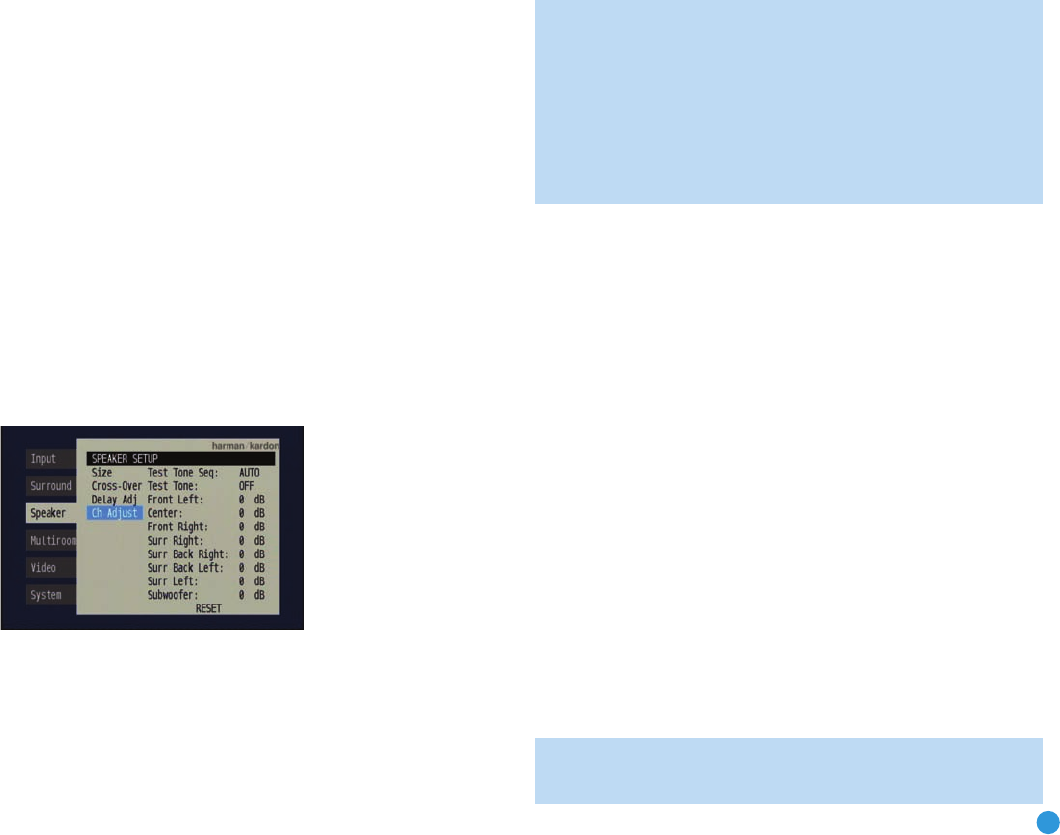
55
ADVANCED FUNCTIONS
a few seconds, it will move to the center channel, then the front right
channel, surround right, surround back right, surround back left,
surround left and finally the subwoofer, displaying the channel name
on the front of the receiver and in the semi-OSD display, as well as the
current level setting (varies between –10dB and +10dB). Press the
⁄
/
¤
Buttons to adjust the level setting, and the tone will remain at that
channel until several seconds after your last adjustment. When you have
finished adjusting the levels, press the Test Button again to stop the tone.
Measure the levels by ear, or using an SPL meter, as described above.
B. Using the Front-Panel or Remote-Control Channel
Command
You may adjust the levels by pressing the Channel Button on the front
panel, and the FRONT L LEVEL message will appear. Use the
‹
/
›
Buttons on the front panel to select the desired speaker channel to
adjust, and press the Set Button when the desired channel is displayed.
The current level for that channel will appear, and you may adjust it
using the
‹
/
›
Buttons. Press the Set Button to return to the speaker
channel choices. This method is not recommended, as you will not be
able to measure the channel levels at the listening position. In addition,
this method requires a source to be playing.
You may also access the Channel command by pressing the Channel
Button on the remote. Use the
⁄
/
¤
Buttons to select the desired
speaker channel and press the Set Button, then use the
⁄
/
¤
Buttons
again to adjust the level. As with the front-panel controls, a source
should be playing for best results. However, the source may be mixed
to highlight certain channels at various times during the selection, which
could skew the results when a different program is played.
C. Using the Full-OSD Menu
Next to EzSet/EQ, the full-OSD menu system offers the easiest and
most flexible manner of setting output levels. Press the OSD Button to
display the menu system, and then navigate to the Speaker tab. Press
the Set Button to display the Speaker Setup menu. Select Manual
Configuration, press the Set Button, and then navigate to the Channel
Adjust line. Press the Set Button to display the Channel Adjust menu.
See Figure 87.
Figure 87 – Channel Adjust Menu Screen
All of the speaker channels will appear with their current level settings.
RESET: If you wish to start by resetting all of the levels to their factory
defaults of 0dB, navigate to this line and press the Set Button. The
levels will be reset.
If you are using an external source to set your output levels, simply
navigate to each channel, press the Set Button and use the
‹
/
›
Buttons to adjust the level as desired.
If you would like to set your levels using the AVR 247’s internal test
tone, adjust the TEST TONE SEQ and TEST TONE lines as follows.
TEST TONE SEQ: When this setting reads AUTO, the test tone will auto-
matically circulate to all channels, pausing for a few moments at each
channel and then moving to the next channel several seconds later, as
indicated by the highlight bar. You may adjust the level for any channel
when the test tone is paused there by using the
‹
/
›
Buttons. You may
also use the
⁄
/
¤
Buttons at any time to move the cursor to another
line, and the test tone will follow the cursor.
When this setting reads MANUAL, the test tone will not move to the
next channel until you use the
⁄
/
¤
Buttons to move it.
TEST TONE: This line determines whether the test tone is active. To
begin the process of setting the levels, press the Set Button and use
the
‹
/
›
Buttons to change the setting to ON. Any time you manually
move the cursor out of the channel listings area of the screen, this
setting will automatically change to OFF, stopping the test tone.
NOTE: Setting the channel levels while one surround mode is
active does not necessarily carry over to all other modes. We
recommend that after you have set the levels satisfactorily in
one mode, you note the results and change to other surround
modes. For those modes that don’t reflect your level settings,
you may either copy the settings you obtained (as a short cut),
or redo the procedure to determine the correct settings for
those surround modes.
Video Adjustments
The AVR 247 includes sophisticated DCDi by Faroudja video processing
that delivers enhanced video quality, even for older analog video source
components, as well as upgraded on-screen displays. When upscaling
video materials from a lower resolution to a higher one (the AVR 247
upscales to a maximum of 720p), the processor is adding pixels to the
original image. Sometimes when converting interlaced video (displays all
odd rows then all even rows of the frame) to progressive-scan video
(displays all rows at once) and increasing the resolution, the interpolation
of new pixels can cause jagginess, or a staircase effect, at edge transitions,
such as between the stripes in an American flag. Faroudja engineers
developed the DCDi (Directional Correlational Deinterlacing) algorithm
to ensure that the additional pixels follow the edge, virtually eliminating
the jagginess and enhancing upscaled images.
The video processor is set at the factory to automatically provide the
best picture as it detects the capabilities of your video display and the
incoming source video signals. However, you may experiment with the
Video Setup menu adjustments to try to improve the picture further. The
Video Setup menu includes a reset feature in the event you wish to
return to the factory defaults and try again.
IMPORTANT NOTE: The AVR 247 cannot convert 1080i or
1080p analog video signals to the HDMI format. This affects
AVR247om.qxd 7/10/07 1:05 PM Page 55
